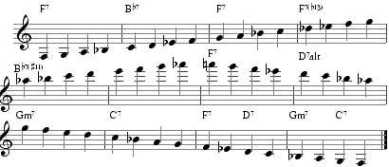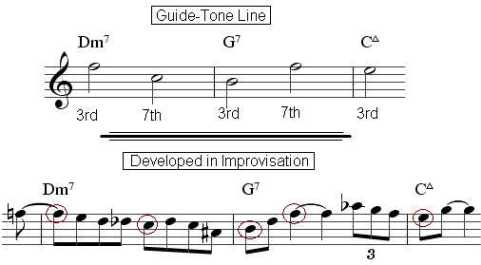
Jazz Improvisation: The Ultimate Guide for Guitarists
Oct 21, 2020Jazz Improvisation: How to Use Scales, Arpeggios and Guide-Tones for Jazz Guitar
What is jazz improvisation?
Jazz improvisation is the art of creating melodic lines spontaneously. The rhythm, melody and harmony inspire jazz improvisation. The goal of the jazz improviser is to invent lyrical, inspiring melodic content within the boundaries of harmony. In fact, great jazz solos are often just outlining the chord changes effectively!
Guidelines for Playing Standards with a Group
When playing standards, musicians will typically play the melody - otherwise known as the head - then take turns playing solos over the "form" of the tune. The "form", as it is often referred to, is the full structure of the tune with the harmonic framework (chords) and melody. So, for example, a very common form is a 32-bar AABA form where each section is divided into 8 bars.

Moving on, each soloist takes turns playing over the entire form and many choose to go over it multiple times. Each "go" around the whole form is called a "chorus." In other words, if you went through the form twice, you played two choruses. If you're playing with a drummer, the drummer might take a solo or trade 4s or 8s with the soloists. These numbers refer to the amount of bars you trade. Lastly, when everyone has taken their solos, the band will usually take the melody out and close the tune.
P.S. As a quick note, if you are playing with a pianist, it is common for the two to take turns comping. If you know each other, you can have some interplay, but as a rule of thumb, it's good for the two to be in agreement about who is comping.
Download ALL Sheet Music for this Lesson
Join our Community here.
It’s good to know that jazz musicians sometimes play "OUT" on purpose where they try to avoid the pre-determined key centers. You may discover that artistic expression is not formulaic after all!
Since this is an instructional website, I will focus on how to play effectively “IN” the changes. To do this, I would like to share three of my favorite jazz improvisation “tools” with you: Scales, Arpeggios and Guide-tones.
The scales, arpeggios and guide-tone sections of this article use audio examples and together will help you outline chords clearly with jazz improvisation on the guitar.
These are the very best jazz guitar lessons you can get on the topic of jazz improvisation and soloing.
Jazz Improvisation Using:
Scales
Please listen to this jazz improvisation introduction audio (mp3) while you check out this lesson. I’ll be walking you through the steps and explaining things a bit further than what’s written out. Feel free to pause the audio as you work things out on your own instrument.
You can take a any jazz chord and create a scale from it. This is the most natural way to construct scales that make sense for the improvisor. This method uses the smallest intervals; those being whole steps and half steps that you would see used in many scales. These intervals are easy to hear and most lullabies and folk tunes contain this scale-wise melodic motion. We can easily take any chord on a staff and spread it out to get our own scale with melodic motion.
Let’s look at the F dominant 7 chord:

Notice how the above scale is much more horizontal than the stack of notes, and both the chord and the scale contain exactly the same notes!
Applying the Scales
The basic steps to apply any scale to a song are as follows:
- Pick a tune and learn exactly one scale for each chord.
- Play the scales up and down throughout the tune “rubato” (no tempo). Each jazz chord has one scale associated to it.
- Then, in strict tempo, play the scales up from degrees 1 to 7.
The first four bars of the "F Blues" using our chord derived scale, goes like this:
While attempting to play the above, stick with familiar fingerings. The goal for now is to hear the progression and not to unlock the entire fretboard.
Here are three more things to consider when trying to figure this out:
- Play bars 3-4 of the PDF back down or descending when needed.
- *Land on different notes when needed (bar 8 of the PDF).
- Play only the “V” scale in “II-V’s” (bars 9-10 of the PDF).
Outlining Jazz Guitar Scales
Once you are familiar with the above process, I recommend you pick a new tune and study its’ scale outline for yourself. Look at different jazz chords, and try to choose appropriate major, minor (dorian) or mixolydian (dominant 7) scales.
I recommend a jazz standard with a 32-bar form, such as “Autumn Leaves”, because more scales are involved. Choose a tune you like and work on it for a while. Select the scales you prefer and experiment with alternatives. This will forge your personal voice for jazz improvisation.
Find out about the Major, Dorian and Mixolydian scales if you don’t know what scales to use. Consult this article called “Jazz Scales: Three Most Used” and then come back here to really get going with your jazz improvisation.
Chord Tones
Let’s add some technicalities to open-up this concept a bit. Try the following two variations:
- Scale degree numbers 1, 3, 5 and 7 are chord tones. Learn to play scales starting from each of these four different chord tones. Start from the easiest, which would be the root. Then, start each scale on the third. Repeat this sequence with the fifth and seventh scale degrees consecutively.
The following is the first four bars of F Blues starting on different chord tones:

- Become as comfortable descending the scales as when ascending them.
This simple scale outlining process will open up new possibilities to you for jazz improvisation.
Outlining Jazz Guitar Scales a Little More
Now that you can play the chord scale outlines to a blues tune plus another standard of your choice, you will probably begin to hear the chord changes more clearly in your head.
It gets easier the more you do it since we’re always dealing with the same kind of scales. Major, minor and dominant are the chords/scales of choice in jazz.
The goal is to know all the scales to all the tunes in your repertoire. It’s simpler than it looks, so go through your repertoire and try it.
Here are two more suggestions to mix-it-up further; choose,
- the chord tones that you start on randomly.
- to ascend or descend the scale randomly.
Here’s a PDF of mixed scale outline on F blues.
It should begin to feel like true jazz improvisation now. Play charts as “semi-improvised exercises”. Make the decisions on the spot and have fun!
More Advanced Jazz Guitar Scale Outlining
Try two of my favorite scale “tricks” that will allow you to hear and play only those notes that sound right. You can do this to any standard jazz tune. Take your guitar improvisation a step further by using the scales you've built from different chords and try this first trick.
- Cover the entire range of the fretboard using the outlined chord scales. Ascend and descend your scales without changing direction when the chord is changing.
So, play the scales ascending from the lowest note available on the guitar and then descend back down from the highest note.
Remember, you have to change the scale when the chord changes, but keep your ascending or descending motion going.

Outlining a chord and using that as your scale is a huge step forward and we’re still just using very basic scales at this point.
Practice
So, keep going for many choruses. You will end up covering different areas of the fretboard at different spots in the form of the song and this may take you out of your comfort zone! After you nail this in quarter notes, do it again in eighth notes but, GO SLOWLY! Do not write anything down and just try to wing it to test your knowledge of the fretboard, the scales and the song.
Here’s an example in this PDF of the entire range outline to help you understand the process. I used different scales just to give you an idea of the potential of this exercise. Don't forget about trick number two:
2. Cover only a small range using the scale built from each chord.
This means to play the scales up and down strictly inside the selected range. Stay within your pre-determined boundaries and change the scale when the chord changes.

Play these for many choruses and you will really understand this chosen area in and out! It is the exact opposite of covering the entire fretboard. Have fun with it!
Please keep in mind that scales are only tools to develop genuine jazz improvisation. It's the emotions that rule, not the tool.
Below are some jazz guitar arpeggios to really get your jazz improvisation chops up to speed.
Jazz Improvisation Using:
Arpeggios
Listen and pause the following audio lesson as you need to. Grab your guitar and let's go.
Arpeggios Are Vertical
As we mentioned above in our scale discussion, scales consist of the smallest of intervals, half and whole steps, whereas, arpeggios consist of larger intervals. They use thirds or fourths for their construction. The most basic arpeggio is a scale constructed from thirds.
Let’s look at the F13 chord to illustrate:

The arpeggio is vertical, with the chord, scale and arpeggio containing the same notes. Compare this to the previous example on scales where horizontal versus vertical was the concept.
Applying the Arpeggio
The basic steps in learning how to use arpeggios are to learn exactly one arpeggio for each chord in the tune of your choice. Stick to the basic 4-note 1-3-5-7 chords and play the arpeggios ascending and descending through the tune “rubato” (no tempo). As usual, play in strict tempo. You can play them ascending in quarter notes and then down in eighth notes.
Here is an example using the first four bars of the “Blues in F” with arpeggios in eighth-notes.
Click here for a PDF (with TAB) of an arpeggio outline for F Blues
Stick with familiar fingerings and hear the progression.
Outlining Jazz Guitar Arpeggios
Once you are cool with this process, pick a new jazz standard with a 32-bar form and study its arpeggios.
Carefully select the tune and work on it for a while. Remember chord tones are scale degree numbers 1, 3, 5 and 7. Start each arpeggio on the third, then repeat by starting on the fifth and seventh and so on.
To help you a bit more, go to the first four bars of “F Blues” we looked at earlier in this article and practice starting on different chord tones. Here’s a link to go there. Maybe you already printed it out.
More Outlining of Jazz Guitar Arpeggios
Knowing all the arpeggios to all the jazz tunes in your repertoire as a goal that is simpler than it looks and obvious patterns will start to emerge after you’ve played arpeggios through a few familiar songs.
Apply the above suggestions and read on for more great stuff on jazz improvisation.
Here are two more arpeggio practicing suggestions to mix-it-up a bit further:
- Choose the chord tones you start on randomly,
- and ascend or descend the arpeggio randomly.
Here’s a PDF of mixed arpeggio outlines on F blues
More Advanced Jazz Guitar Arpeggio Outlining
It is possible to play from different arpeggio segments.

Re-do the “Outlining Jazz Guitar Arpeggios" and “More Outlining of Jazz Guitar Arpeggio" sections using 3-5-7-9 instead of 1-3-5-7.
You can also play with 5-7-9-11 and even 7-9-11-13 if you wish!
Work on one segment at a time to “get” the concept and the sound.
Last but not least, please read again the “More Advanced” part of the “Scales” section of this article and adapt the “entire range” and the “small range” exercises for arpeggio playing, just as you did for scales. Work with different 4-note arpeggio segments as well.
Remember, arpeggios are only tools to develop genuine jazz improvisation and they alone will not make music for you, but they will help you hear through chord progressions.
Let’s talk guide-tones.
Jazz Improvisation Using:
Guide-Tones
Guide-Tone Lines are Slooooow
Jazz improvisation uses guide-tones almost all of the time. After you listen for guide-tones when listening to your favourite jazz tunes, you will hear them almost everywhere.
Experienced jazz improvisers naturally ornament, develop, displace or simply leave out the inherent guide-tone line while soloing. This may sound technical, but first and foremost, you’ve got to get a feel for hearing them.
Those slow-moving melodies we all like consist of chord-defining tones played in long durations. They will guide your ears so to speak. The chosen “strong” notes that constitute guide-tone lines are most likely the ones that naturally resolve. For example, on a G7 to C (V-I) progression, the strongest resolution is from B to C.
So, every chord progression has specific guide-tones and because jazz improvisation relies on guide-tones, it’s fairly important to understand them.
Here’s an example demonstrating the use of 3rds and 7ths as “anchors” for a II-V-I progression in C major:

The above jazz improvisation, made up of thirds and sevenths, could have been sparser, denser, trickier, bluesier, and interpreted in many other different ways, all the while remaining anchored in the selected guide-tones.
Applying Guide-Tone Lines
The thirds and seventh intervals are a chord’s most defining tones. As a starting point, we’ll use them exclusively. I suggest you play the root of each chord at the same time as the 3rds and 7ths. This will help your ears to place in context these guide-tone intervals.
- Pick a tune of your choice and identify the third and seventh of each chord.
- Play the 3rds and 7ths rubato throughout the tune.
- Compose a line using whole notes to play the thirds and sevenths of the tune.
For example:
Click here for a PDF (with TAB) of a guide-tone line on “Lady Bird”.
The basic idea is to hear through the tune’s progression using only two tones. Stick to the line you composed with whole notes and play it many times until you really hear it in your mind. Listen to it again in your mind without playing the guitar. Identify those two tones.
Jazz Guitar Guide-Tones
Pick a new tune and compose a guide-tone line consisted of 3rds and 7ths in whole-notes.
I recommend a jazz standard with a 32-bar form.
Carefully select your tune and work on it for a while. Once you can play and hear your own 3rds and 7ths guide-tones line, try the following:
- Ornament the whole-notes with faster lines using scales and arpeggios.
- Use interesting rhythms but keep the guide-tones mostly on beat 1.
- Try placing the anticipation on the “and” of beat 4.
For example:
Remember, create a specific guide-tone line and stick to it. The more you work on the same specific guide-tone line, the better you will hear its respective chord progression internally in the future.
More Jazz Guitar Guide-Tones
Now you can play the thirds and sevenths plus some ornamentation on a jazz tune. You should begin to hear the chord changes clearly in your head at this point.
The next step is to incorporate all of the basic chord tones (1, 3, 5 and 7) as well as using whole notes and half notes to build guide-tone lines.
Try the following:
- Compose a guide-tone line made of thirds, sevenths, fifths and roots and
construct this new guide-tone line in whole and half note durations.
For example:
When you have solid guide-tones deeply ingrained in your ears and fingers, try to ornament them in the following ways:
- Ornament with faster lines using mostly scales and arpeggios.
- Use interesting rhythms, freely displacing guide-tones.
For example:
It becomes clear that the possibilities are endless. You can develop guide-tones infinitely once you have mastered the technical tools that we have described in this article.
As you can see, knowing how to start scales and arpeggios on different chord tones, and different beats, comes in handy.
Advanced Jazz Guitar Guide-Tones
Finally, you can enjoy the process of creating and developing long and simple melodies in a myriad of different ways.
For instance:
- Create guide-tone lines using any scale notes (1-3-5-7-9-11-13).
- Create guide-tone lines strictly made of extensions (7-9-11-13).
- Learn guide-tone lines from recordings by simplifying fast lines.
Using the above suggestions, ornament:
- development strictly on the rhythms you’re using.
- strictly on melodic motifs you’re creating.
- using any rhythmical or melodic techniques.
Remember to clearly define your guide-tones and your improvised lines will make sense! In fact, it is a good idea to play all the “wrong notes” (ornaments) while still putting emphasis on the “right” guide-tones. You’ll be amazed!
And finally, my favorite guide-tone exercise:
- Create a guide-tone line in whole notes that strictly ascend/descend to the next available scale note and remember to develop it creatively.
For example:
Conclusion
Remember that the emotions you want to convey are above any rules and the tools that we have described and worked with in this article are only tools to master in order to allow you to just be and create in the moment.
Download ALL Sheet Music for this Lesson
Join our Community here.
Now, that’s jazz improvisation!
















